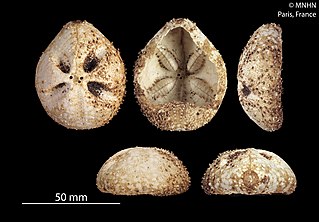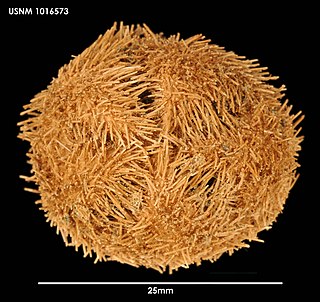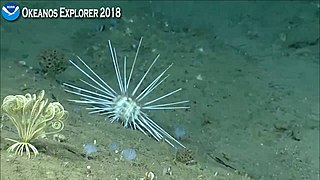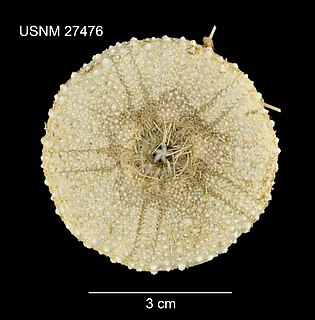
The Diadematidae are a family of sea urchins. Their tests are either rigid or flexible and their spines are long and hollow.

The Echinothurioida are an order of sea urchins in the class Echinoidea. Echinothurioids are distinguished from other sea urchins by the combination of a flexible test and hollow spines. The membrane around the mouth contains only simple plates, in contrast to the more complex mouth parts of their close relatives, the Diadematoida. They are nearly all deepsea dwellers.

The Camarodonta are an order of globular sea urchins in the class Echinoidea. The fossil record shows that camarodonts have been in existence since the Lower Cretaceous.

Amphipneustes davidi is a species of sea urchin of the family Temnopleuridae. Their armour is covered with spines. It is placed in the genus Amphipneustes and lives in the sea. Amphipneustes davidi was first scientifically described in 2010 by Madon-Senez.

Amphipneustes koehleri is a species of sea urchin of the family Temnopleuridae. Their armour is covered with spines. It is placed in the genus Amphipneustes and lives in the sea. Amphipneustes koehleri was first scientifically described in 1905 by Ole Mortensen.
Antrechinus nordenskjoldi is a species of sea urchin of the family Urechinidae. Their armour is covered with spines. It is placed in the genus Antrechinus and lives in the sea. Antrechinus nordenskjoldi was first scientifically described in 1905 by Ole Theodor Jensen Mortensen.
Araeosoma owstoni is a species of sea urchin of the family Echinothuriidae. Their armour is covered with spines. It is placed in the genus Araeosoma and lives in the sea. Araeosoma owstoni was first scientifically described in 1904 by Ole Theodor Jensen Mortensen.
Araeosoma violaceum is a species of sea urchin of the family Echinothuriidae. Its armour is covered with spines. It is placed in the genus Araeosoma and lives in the sea. A. violaceum was first scientifically described in 1903 by Ole Theodor Jensen Mortensen.
Asthenosoma dilatatum is a species of sea urchin of the family Echinothuriidae. Their armour is covered with spines. It is placed in the genus Asthenosoma and lives in the sea. Asthenosoma dilatatum was first scientifically described in 1934 by Ole Theodor Jensen Mortensen.
Breynia elegans is a species of sea urchins of the Family Loveniidae. Their armour is covered with spines. Breynia elegans was first scientifically described in 1948 by Ole Theodor Jensen Mortensen.

Calocidaris micans is a species of sea urchins of the Family Cidaridae. Their armour is covered with spines. Calocidaris micans was first scientifically described in 1903 by Ole Mortensen.
Ceratophysa rosea is a species of sea urchins of the Family Pourtalesiidae. Their armour is covered with spines. Ceratophysa rosea was first scientifically described in 1879 by Alexander Emanuel Agassiz.
Chaetodiadema africanum is a species of sea urchins of the Family Diadematidae. Their armour is covered with spines. Chaetodiadema africanum was first scientifically described in 1924 by Hubert Lyman Clark.

Chaetodiadema granulatum is a species of sea urchins of the Family Diadematidae. Their armour is covered with long and slender spines, and the test is quite flattened.
Chaetodiadema keiense is a species of sea urchins of the family, Diadematidae. Their armour is covered with spines. Chaetodiadema keiense was first scientifically described in 1939 by Ole Theodor Jensen Mortensen.

Chaetodiadema pallidum is a species of sea urchins of the Family Diadematidae. Their armour is covered with spines. Chaetodiadema pallidum was first scientifically described in 1907 by Alexander Emanuel Agassiz and Hubert Lyman Clark.
Chaetodiadema tuberculatum is a species of sea urchins of the Family Diadematidae. Their armour is covered with spines. Chaetodiadema tuberculatum was first scientifically described in 1909 by Hubert Lyman Clark.

Chondrocidaris gigantea is a species of sea urchins of the Family Cidaridae. Their armour is covered with spines. Chondrocidaris gigantea was first scientifically described in 1863 by Alexander Agassiz.

Chaetodiadema is a genus of sea urchins of the Family Diadematidae. Their armour is covered with spines.

Araeosoma is a genus of deep-sea sea urchins in the family Echinothuriidae.










